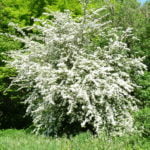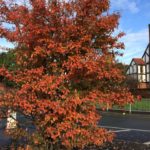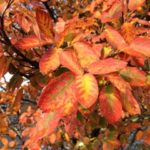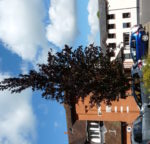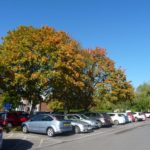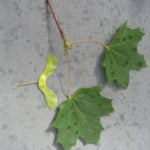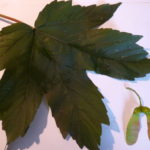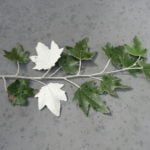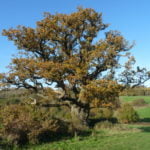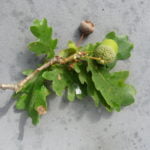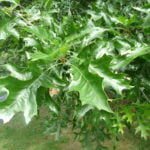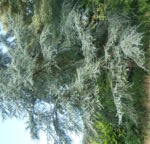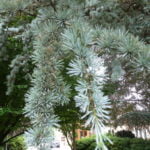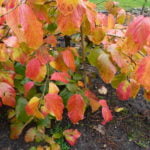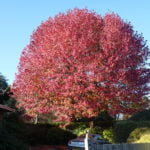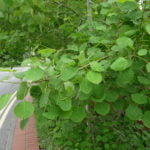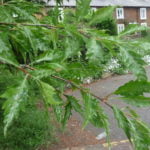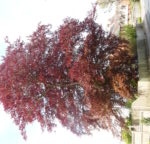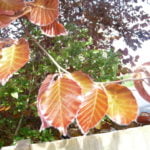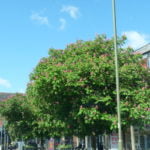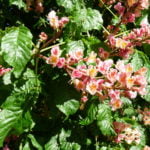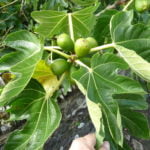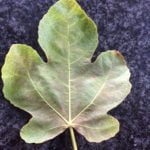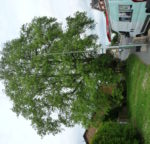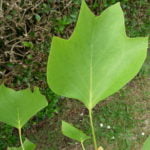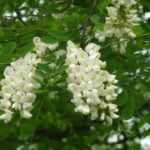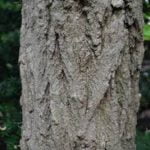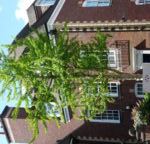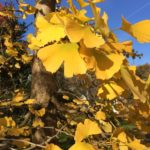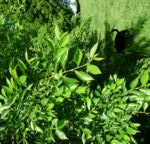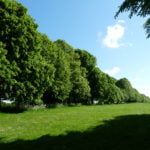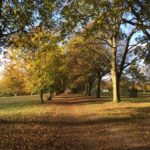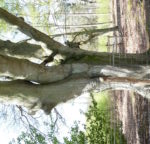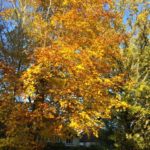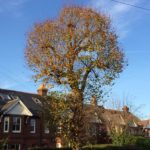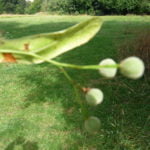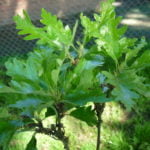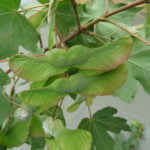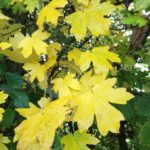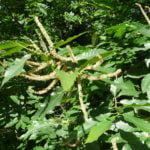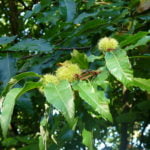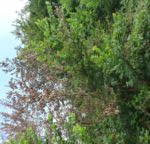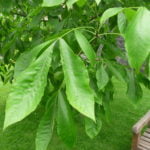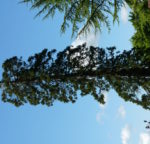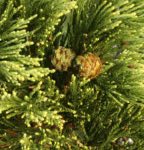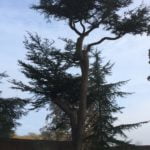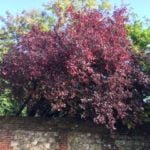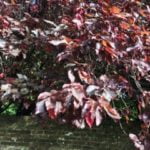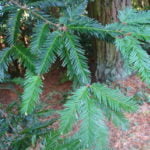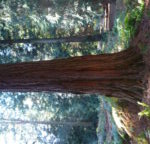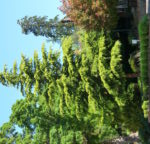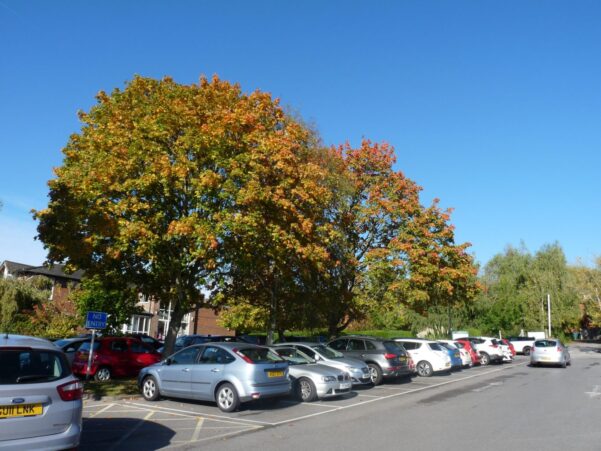
Farnham Tree Trail Guide II
Farnham’s second tree trail is a self-guided walk devised by Peter Bridgeman.
This trail includes trees within the Victoria Garden, the Haren Garden, Borelli Walk, the leisure centre, East Street, the southern part of Farnham Park including The Avenue, the grounds of Farnham Castle and the top of Castle Street.
Download your map of the Farnham tree trail guide II or see the first Farnham tree trail guide.
The Victoria Garden |
|
| 1. Hawthorn or quickthorn (Crataegus monogyna) | |
| A common small native tree or hedging plant producing masses of white flowers in May and is often called May blossom and with red fruit or haws in the autumn. If you see similar bushes flowering in March it will be a blackthorn (Prunus spinosa) or sloe. The sloes or small plums in the late summer are bitter but useful for making sloe gin! | |
| 2. Snowy mespilus (Amelanchier larmarchii) | |
| A large shrub or small tree originally form the North America but naturalized in Europe and Britain. Lovely, but brief white flowers in spring at the same time as coppery pink new foliage which turn to green then dramatically to red in the autumn. | |
|
The Victoria Garden was created in 1997 on the site of the former Victorian open-air swimming baths and is maintained by volunteers. It is well worth spending time here. It is like a secret garden and has won awards from the RHS and gold medals in the Britain in Bloom competition. |
|
Rear of Council Offices |
|
| 3. Purple Dawyck beech (Fagus sylvatica ‘Dawyck Purple’) | |
| The original green upright or fastigiate Dawyck beech was discovered at the Dawyck Botanic Gardens, near Pebbles, Scotland in the mid-19th century. This purple form, like a golden type, was raised in Holland in the mid-20th century. A splendid, tall specimen tree – but this one is a little hidden. There are three other beech on this tour, including the native common green as well as purple and cut-leaved cultivars. There is also a weeping beech along West Street. | |
The Haren Garden |
|
| 4. Norway maple (Acer platanoides) | |
| A large impressive tree from Europe and long cultivated in this country. There are many cultivars including purple, golden, variegated, cut-leaved and erect types. Note the angles of the seed wings compared with sycamore and field maple. | |
| 5. Sycamore (Acer pseudoplatanus) | |
| Another large tree in the maple family originally from Europe and Western Asia but long established in this country where it can become a weed problem with its abundance of seedlings. Again there are many cultivars. The timber is used in furniture making and treen. There is a field maple later in the tour and these three maples can be readily identified by their leaves and the differing angles of the seed wings. |
|
| The Haren Garden commemorates the friendship between the people of Farnham and those of Haren in the Netherlands by whom the plaque was presented. People of Farnham sent food parcels to Holland at the end of WWII and again helped following the North Sea floods in 1953. | |
Into Borelli Walk |
|
| 6. White poplar (Populus alba) | |
| Long cultivated and naturalized in this country and readily reproduced from suckers. It is often a multi-stemmed low spreading tree but we will see some larger specimens at the Sports Centre. Gets its name from the white under side of the leaves. Attractive whitish bark with dark diamonds. Like most poplars it is relatively short lived. | |
| 7. English or pedunculate oak (Quercus robur) | |
| Probably the most well known of our native trees producing a large spreading and long lived tree with some in Farnham Park dating back 500 years. There is another native oak, Quercus petraea or the sessile oak. Sessile means stalkless and this appears confusing as the leaf of Quercus petraea has a leaf stalk and Quercus robur does not. The term sessile here refers to the stalkless acorn. There is an evergreen oak in the Library Gardens in West Street and in Wrecclesham and an upright or fastigiated oak outside the Maltings café and at the Water Lane Sainsbury’s. All are recognised by the unique acorn seed. | |
| 8. Red oak (Quercus rubra) | |
| A native of North Eastern America and Eastern Canada and introduced into Britain in 1724. A large spreading tree with brilliant red autumn colour. Grown as a timber tree in America but as an ornamental in this country, it does not grow so well up north. There are good large specimens in Beavers Road. | |
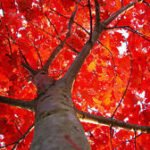 |
|
| 9. Atlas cedar (Cedrus atlantica) | |
| The green leaved tree originating from the Atlas mountains of Algeria and Morocco was introduced into this country in the mid-19th century. This specimen is the blue Atlas cedar (C. a. ‘Glauca’). There are also a golden, upright and a weeping cultivars. There is a large specimens of the Atlas cedar at Farnham Castle and there is another fine specimen at the War Memorial near to St Thomas-on-the-Bourne Church. | |
| 10. Persian ironwood (Parrotia persica) | |
| A small to medium-size, often low-spreading tree with peeling bark like the London plane and splendid autumn colour. Originating from Northern Persia (Iran) to the Caucasus and introduced in 1841. This particular tree is Parrotia persica ‘Vanessa’, a cultivar with a more tree-like habit and was raised in Holland in the 1970’s. | |
| 11. Sweet gum (Liquidambar styracifera) | |
| A native of E.USA and introduced into this country in the 17th century. Grows into a large tree with selected forms having wonderful autumn colour, one of the best is for this is the cultivar Liquidambar styracifera ‘Worplesdon’ There are many good specimens around the town with one with great autumn colour on Bourne Green. | |
| The Borelli Walk along the River Wey off South Street was named in honour of Charles E Borelli a prominent resident of Farnham and Chairman of the former Farnham Urban District Council for many years until his death in 1950. Much of his work was in conjunction with Harold Falkner, Farnham’s famous architect and together they founded the original Farnham Society in 1911. | |
Over the footbridge to the Sports Centre |
|
| You will see large specimens of purple Norway maple and white poplar. | |
| 12. Aspen (Populus tremula) |
|
| A medium size tree, long established in this country but originally from Europe, Asia and Northern Africa. Readily distinguished from other poplars by the trembling foliage even in light winds due to its slender, flattened leaf stalk. Found outside Lidl. | |
Through to East Street |
|
| 13. Cut or fern-leaved beech (Fagus sylvatica ‘Asplenifolia’) | |
| A long established cultivar of the common beech with long, deeply cut leaves looking like a fern. Forms a very attractive large tree. There is a good specimen near the library in Aldershot. This one is suffering from an invasion of wooly scale insects on the trunk and branches. The insect is hidden by white down and, although not particularly damaging, they can weaken the tree and more importantly allow the entry of the more serious beech bark disease, caused by a fungus. | |
| 14. Copper or Purple beech (Fagus sylvatica ‘Riversii’) | |
| Another cultivar of the common beech. There are many examples of this cultivar in Farnham which exhibits wonderful coppery coloured leaves in the spring but change to a rather dull dark purple in summer. | |
To the front of the Woolmead |
|
| 15. Red horse chestnut (Aesculus x carnea) | |
| A hybrid between A. hippocastanum, the common white species and A. pavia. This is a more compact tree and is likely to be the cultivar ‘Briotii’. There are other specimens of the common and red horse chestnut in Farnham Park. | |
Up Bear Lane |
|
| 16. Fig (Ficus carica) | |
| Originating in Western Asia but grown in this country since the early 16th century, there are many varieties producing the edible fruit which take two years to develop. The leaves vary in size. However all have this very distinctive shape. Best grown against a wall. | |
Into Farnham Park |
|
| 17. Tulip Tree (Liriodendron tulipifera) | |
| Ultimately a large tree from the eastern side of North America and introduced in 1688. It has very distinctive leaves which turn a rich butter- yellow in the autumn and tulip-like flowers in June/July. There is a large specimen standing in the grass verge on Farnborough Road near Optiplan Kitchens showrooms. | |
| 18. False acacia (Robinia pseudoacacia) | |
| A native of USA but found in this country since 1600 and now naturalized, it produces a good display of large pea-like white flowers in May/June. There is a large specimen at the top of Green Lane. There is an attractive compact yellow-leaved cultivar Robinia pseudoacacia ‘Frisia’ but this is prone to disease. | |
| 19. Maidenhair Tree (Ginkgo biloba) | |
| Introduced in 1754 from China with an early planting at Kew Gardens in 1762 which is still there. In its native China there are specimens some 3,000 years old. This is a very ancient species pre-dating the dinosaurs and thought to go back 150 million years. The oddly shaped leaves are easily recognisable and there is a smaller specimen a little later in the trail. |
|
| 20. Japanese Elm (Ulmus davidiana var. japonica) | |
| Planted here on the recommendation of the Forestry Commission following the loss of the elms in The Avenue in the 1970’s as it was thought to be resistant to Dutch Elm Disease. This has proved to be the case but due to a weak branch and fork structure several have fallen apart and their future will need to be assessed. | |
The Avenue |
|
| The avenue of huge elms was one of the main tree features running though the centre of the park for 1km. During the 20th century some of these had to be felled and replaced but the final blow was the introduction of the more virulent form of Dutch Elm Disease which killed the remainder. | |
| 21. Beech (Fagus sylvatica) | |
| One of the most noble and versatile of our native trees with many attractions from lime green spring foliage, deep summer shade and glorious yellow to gold to copper autumn colours. It is grown as a timber tree for furniture, a stately parkland tree or as a domestic garden hedge with the dead leaves persisting through the winter. Not as long lived as, say, the oak but there are late 18th century specimens at the southern edge of the RSPB reserve at Bourne Wood. Pigs even eat the seeds known as beech mast. There are many cultivars and there is a weeping beech along West Street. |
|
| 22. Limes (Tilia species) | |
| There are over 20 species of lime grown in this country. The common lime (Tilia x europaea) and Tilia platyphyllos, the broad-leaved lime, are the most commonly planted but both produce honey-dew, a troublesome sticky substance caused by sap-sucking aphids. Both are tall stately trees suitable for parkland and for roadside planting as they tolerate heavy pruning and pollarding. Tilia x euchlora is another, slightly smaller species which does not suffer from honey-dew. Tilia cordata is a smaller-leaved native but is not commonly seen in this area. All have heart-shaped leaves and a unique seed and seed wing. | |
| 23. Turkey Oak (Quercus cerris) | |
| A native of Southern Europe and Asia Minor and now naturalised in Great Britain. A very fast- growing large tree but unlike the English oak, the timber has little value. Readily distinguished from the common oak by scale-like hairs on the buds and acorn cups. There is another large specimen on Langham Recreation ground in The Ridgeway. | |
| 24. Field Maple (Acer campestre) | |
| A medium sized native tree commonly seen on chalk soils as a stand-alone tree or as part of a hedgerow. Produces lovely butter yellow autumn colour. There are two other common maples, the sycamore and Norway maple. Note the 180 degree angle of the seed wings. | |
Near the cricket ground |
|
| 25. Sweet Chestnut (Castanea sativa) | |
| A long-lived, drought-resistant large tree which originated from North Africa and Asia Minor but was likely imported to Britain by the Romans. Large spear like leaves are quite distinct. Produces long yellowish catkins in July, followed by the edible chestnuts housed in a very prickly seed case which helps protect them from being consumed by animals. It has been used as timber for centuries as it makes very durable timber and responds well to coppicing (cutting back to ground level on a cycle of years). | |
| 26. English Elm (Ulmus procera) | |
| This large native tree was a common and very impressive site in hedgerows and field boundaries and an important timber tree but most were lost in the 1970’s when a more virulent form of Dutch Elm Disease was imported from the USA on infected timber. It has been estimated that over 20 million trees were lost. The fungus is unknowingly spread by the elm beetle which transmits the disease from an infected tree to a healthy one. There is hope of a cure but at this time suckers, will grow from the deceased tree and they will be free of the disease until the bark is thick enough to provide a nesting site for the female beetle to lay its eggs. There are a few remaining pockets of mature elms, the best being in Brighton, which holds the ‘National’ collection of elms. | |
Farnham Castle |
|
| 27. Hickory (Carya species) | |
| There are several species of hickory grown in this country and this is likely to be the shagbark hickory (Carya ovata) introduced from the States in the 17th century. Another hickory (Carya illinoinensis) produces the pecan nut in America. The very large pinnate leaves are up to 50cm in length and produce lovely yellow autumn colours. It’s in the same family as walnut. There is a larger specimen at the Alice Holt Arboretum. | |
| 28. Giant redwood or Wellingtonia (Sequoiadendron giganteum) | |
| A native of USA and introduced into this country in 1853. There is an early planting at Stratfield Saye planted in 1857 on the death of the Duke of Wellington; hence the common name in the UK but he had nothing to do with the tree. In California one of these trees, ‘The General Sherman’ is some 84m tall, weighs around 2,500 tons and is estimated to be about 3,000 years old. Occasionally trees in this country get above 50m. This one is 30m-plus but has lost its top few metres. | |
| 29. Cedar of Lebanon (Cedrus libani) | |
| A large broad-crowned tree, a native of South West Asia and Syria and introduced into this country in the mid 17th century. Not as fast-growing as the Atlas cedar but it does achieve great size and spread with huge flat tiered branches. This one is a little battered by its exposed situation and there is a better specimen in the museum gardens in West Street and some old vets at Rangers House, Farnham Park. | |
Back to Castle Street |
|
| 30. Purple-leaved plum (Prunus cerasifera ‘Pissardii’) | |
| A small tree a native of Persia and introduced in the late 19th century. It has attractive white/pinkish flowers in very early spring but forms into a rather scruffy, twiggy tree and Alan Mitchell, Farnham’s late, great tree man, called it ‘the unsightly pissy plum’ – judge for yourselves. There’s one planted outside Cote Brasserie in the Lion and Lamb Yard. | |
| 31. Coast redwood (Sequoia sempervirens) | |
| The other of the redwood trees from USA, this one grows nearer the coast in California and Oregon and was introduced into this country in the 1840’s. In its natural habitat it will grow to 100m-plus and is a contender for tallest tree in the world, but some say the gums (Eucalyptus) in Australia would challenge that. There are good specimens of both redwoods in the Alice Holt Arboretum | |
| 32. Deodar or deodar cedar (Cedrus deodara) | |
| The cedar is readily recognised by its drooping leading shoots. A native of Western Himalaya which first came to the UK in 1831. Grows to a large, splendid tree and this one is likely to be the golden form Cedrus deodara ‘Aurea’ with bright yellow spring growth turning green/gold by summer. | |
